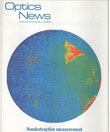
February, 1986 Issue
Feature Articles
Nondestructive measurement of subsurface structural defects in polished single-crystal silicon
A correlation has been found between scattering levels measured by a new photon backscattering technique and lattice damage revealed by etching polished and ion-implanted silicon wafers. The surfaces of the wafers appeared featureless when observed by Nomarski microscopy and no roughness differences could be measured by diamond stylus profilometry before etching. Photon backscattering thus appears to provide a nondestructive method for inspecting for subsurface damage in silicon wafers. A byproduct of the study was the finding that etched, ion-implanted silicon wafers which clearly showed the imprint of the mask used for the ion implantation did not have steps or height differences between ion-implanted and untreated areas. This result indicates that the etch rate was the same for ion-implanted and untreated areas, but that the optical constants of the material appear to have changed in the implanted regions.
by Robert M. Silva, Fred D. Orazio Jr., and Jean M. BennettNew Designs for Large Telescopes
Both telescopes and microscopes have been with us for several hundred years now. The latter optical device has evolved by an enormous amount, and I have at home a stereo zoom microscope with a 7X zoom ratio. By contrast, I also have a telescope with which Isaac Newton would have felt right at home. The evolution of telescope designs has been very slow indeed. Except for the rapid invention of window shades and Venetian blinds, shortly after Galileo started to popularize the first telescope, there have been very few developments related to this optical instrument. This is partly because astronomers tend to be very conservative types. They try to minimize the number of optical surfaces so as to avoid light loss, and are hesitant to build very expensive large telescopes, except in proven, traditional designs.
by David Shafer
![Infinity Mirrored Room– Brilliance of the Souls 2014 by artist Yayoi Kusama. [© YAYOI KUSAMA]](https://opnmedia.blob.core.windows.net/$web/opn/media/images/articles/2024/0724/departments/202407-cover-web.jpg?ext=.jpg)
![An experimental scheme demonstrated by researchers at Princeton and Yale universities, USA, can convert physical noise into errors that can be corrected more easily. [F. Wojciechowski, Princeton University]](https://opnmedia.blob.core.windows.net/$web/opn/media/images/articles/2024/0624/departments/202406-cover-web.jpg?ext=.jpg)
